|
Hello Electrified Miata and Formula Mazda-E fans! Our goal from last week was to spin the wheels of the car now that the motor is installed. One little wire slowed us down as we moved from 'bench testing' to 'in the car testing'. Join us on the journey to go faster through the science of electricity, magnetism and computers.
During reconfiguration it was time to charge the main battery pack. The pack had discharged from 358 volts to 348 volts. The largest module in the pack had never been charged, and the 2 smallest modules had been discharged on the go-kart. The charging method preferred for these cells used in the modules (LG MJ1's) is a constant current of 3.4 amps maximum until 80% charged followed by constant voltage. Since the modules have 22 cells in parallel, this totals up to nearly 75 amps. The normal charging current is half that, 37.4 amps. At a pack voltage of 350V, this represents 13 kilowatts, or approximately one hundred thirty one, 100 watt light bulbs. That's a lot of power, more than a 50 amp 220 volt socket can carry! I charge at 1/10 of that rate with my 1960's Variac auto transformer and a DC bridge rectifier. The two smaller modules charged in one day, and the larger module took a day by itself. Part of the reason for the longer charge time on the larger module was not being able to charge at a constant current. I set the Variac to charge at about 3.5 amps, the most it can do in the hot garage without too hot. However as the pack charged, the voltage would rise and the current would decrease, which made the module charge slower. I compensated for this by checking the pack every hour and adjusting the Variac until the current rose to 3.5 amps again. The rising voltage effect was more noticeable on the larger 32 cell module than the smaller 12 cell modules. That is why EV car chargers have a constant current option to charge at the fastest rate. The charging rate is limited to current the charger can handle and how large an outlet we have at the house. While the batteries were charging, I installed the driveshaft, transmission tail mount, filled the transmission with gear oil and tightened all the power train mounts. When car night arrived, we were nearly ready to test the motor in the car. We had to make some extensions for the motor control Pi. Nolan handled the inverter power extension while Bruce handled the Ethernet extension. Bruce and my nephew Torstan worked on the battery pack extension while Eric handled re-assembling the shifter and installing new rubber for the boot and dust cover. Dave Evans and Bruce were determining how to route the cooling hoses and where to place the pump. Since a Nissan Leaf in a Mazda Miata configuration isn't stock, we'll need to fabricate some new hoses or cut pieces from hoses that have the right bends in them. We were all ready to turn the car on and start the main battery connection procedure. There are times to take risks, and there are times to play it safe. The turn on sequence after re-configuration is one of those times to be safe since the inverter has large capacitors in it and the battery, freshly charged to 364 volts from 348. Yes, I'm staying well clear of the 400 volt maximum until we get BMS supervision. Even with lower voltage, there is plasma generating current, which generally means finding and destroying the weakest link if something goes wrong. Step one of the turn on sequence is connecting the negative contactor and powering the inverter. The inverter will run for 10 seconds before it faults without a high voltage source. The inverter reports the pack voltage during it's pre-charge sequence. The inverter didn't power up and we checked the new wiring. The new wiring was correct, but the relay to conduct power to the inverter wasn't working. The Pi signals to the relay were also working correctly and we found a wire between the Pi and the relay board had broken. Nolan and Bruce re-soldered but we had run out of time on car night. I was certainly disappointed at not seeing the wheels turn this week. That will be another milestone for next time. Thanks to Dave, Bruce, Eric, Nolan and Torstan for getting us one step closer to running this car! Due to vacations and life, I won't be writing to y'all for another three weeks. However, this means we can focus our attention on the Formula Mazda-E for a few weeks and work on welding the battery trays together and test fit them to the car. Stay tuned. We will get the wheels turning on this car! As always, thanks for reading.
0 Comments
Leave a Reply. |
AuthorBill likes cars that understand the 'go fast now' pedal. Archives
May 2022
Categories |
Proudly powered by Weebly


 RSS Feed
RSS Feed